Keeping cats off of furniture can be really hard for pet parents. One of the most frustrating things that cat owners deal with is your furry friend shredding your brand-new leather sofa or velvet drapes.
However, if you want a well-behaved cat who won’t destroy your home as soon as you leave, it’s crucial to train your cat well to avoid climbing & scratching behaviors. Not only will this give you peace of mind whenever you leave the house, but it will also improve your cat’s obedience level & make it easier to teach him tricks later on in life.
Read on to find some helpful tips and some frequently asked questions about cat climbing & cat scratching!
Why Do Cats Climb On Furniture?
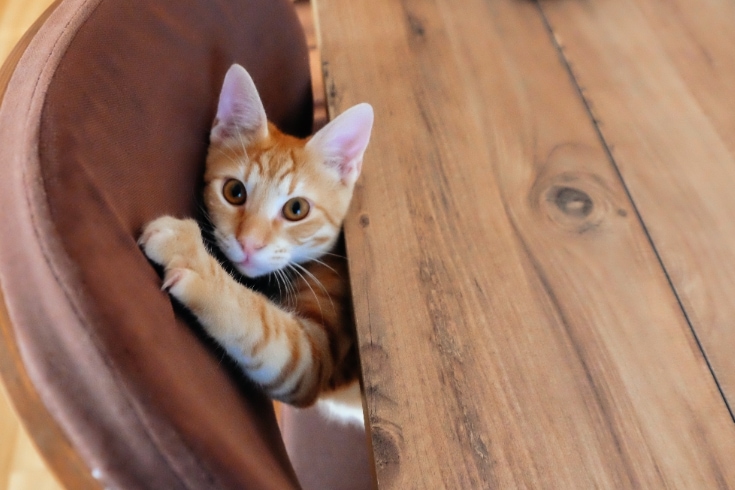
Cats climb on furniture because it satisfies their natural curiosity and provides them with a strategic lookout point to monitor their environment. This behavior is an instinctive trait passed down from their ancestors who used elevated positions for hunting and security.
Natural instincts of cats
Cats are natural predators to ground animals like mice, birds, and rabbits. However, they are also prey to larger animals like dogs, coyotes, and large birds. Therefore, by prowling in the trees, cats are able to observe their prey & also keep themselves safe from predators.
Therefore, climbing onto your furniture, counters, and shelves, is actually an innate behavior that is based on evolution.
Exploration and observation
Ever heard the phrase “Curiosity killed the cat”? Cats are naturally inquisitive creatures & being way up on your sofa gives them a great vantage point to observe the goings-on of the house.
Territory marking
If you’ve ever been around a friendly cat, you might have noticed how quick they are to rub their cheeks & flank on your legs.
This is actually a form of territorial marking; the cat is using the glands on their cheek to rub their own pheromones on you, thereby marking you as their property.
Often, our kitties will want to do the same to every piece of furniture in the house. So, they may climb up on the back of your sofa to mark every inch of their territory!
Safety and Security
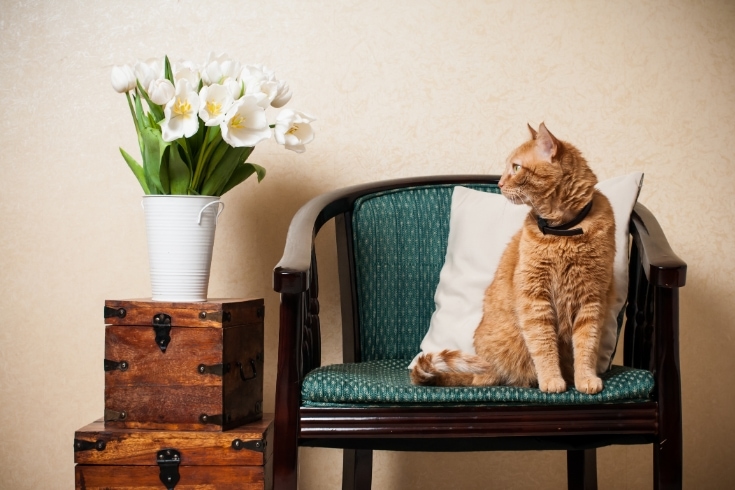
Being up high can reduce your cat’s anxiety because they can see everything, including any potential threats. This can give them a sense of security because they feel safe up on this vantage point.
Resting and relaxation
Sometimes, that spot high up is just so much more comfortable than any other location! Your cat may enjoy relaxing up on his perch.
Exercise and agility
Climbing up all those sofas & shelves may actually be quite rigorous for your kitty. It’s a great way for your cat to get that stimulation & playtime that every kitty needs.
Entertainment and play
Cats like to challenge themselves, and there is no greater challenge than trying to get up as high as possible. They consider that vertical space a maze, and it’s fun for them to reach the highest point possible.
Attention-seeking
Some kitties love to put themselves up on a pedestal, and what better way than literally putting themselves way up on a pedestal? Cats will often clamber onto furniture if they want you to notice them & pay attention to what they are doing.
Factors influencing cats’ behavior on furniture
Here are a few factors that can lead to cats climbing on furniture more often.
- Boredom
- Little vertical space
- Lack of mental stimulation
- Cold temperatures (cats will seek warmer, higher spots)
- Too many other cats in the house
What are the consequences of cats on furniture?
So, what’s wrong with having your cat climb up on your furniture in the first place? Here are a few potential consequences of letting your cat go wild.
Potential damage to furniture
When your kitty climbs up on your furniture, he can access a whole new domain of destruction! Up on the back of your sofa, your cat may be able to rip up the fabric, chew loose threads, and scratch up the wall.
Not only can this damage your furniture, but it can also cause potential harm to your kitty’s health. If he ingests something he shouldn’t, you may need to make a visit to the vet to get him checked up.
Health risks for family members
If you have a member in your family that is immunocompromised, there is a chance that having your cat up on the furniture can cause more health issues. Having cats up on the furniture can also cause more severe allergic reactions if someone in your home is prone to them.
What do I need before training my cat?
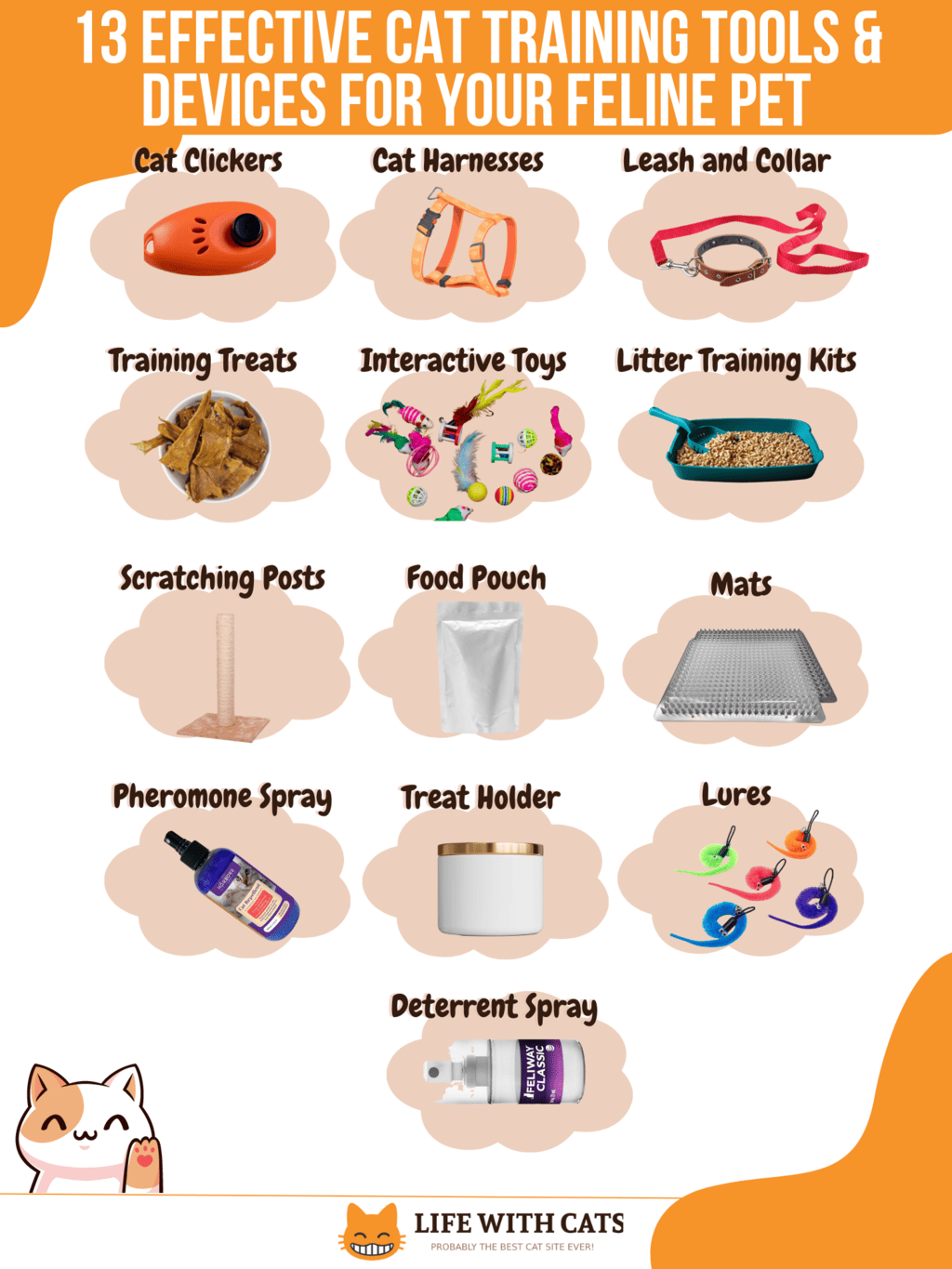
So, if you’re ready to train your cat to stop climbing, you may need to prepare a couple of things to make the process easier.
Identifying suitable training tools
Every pet owner knows that the best way to simplify the training process is to find the best training tools. If you find out what motivates your kitty, you will be able to train him well because he will really look forward to being rewarded.
Most cats will really appreciate high-quality cat treats, such as hard-boiled eggs, cooked lean meats, and cooked fish.
For some cats, a simple stroke on the back is enough to make them happy! Try out a couple of rewards and see what he prefers the most.
Understanding the importance of patience
The most important thing to remember is to be patient. Your cat’s furniture manners could take weeks, or even months, to develop. Throughout the whole process, you must stay consistent with your training & never raise your voice or hands at your cat.
This will only further confuse him, and create stress, anxiety, and negative associations with training.
How To Keep Cats Off Furniture?
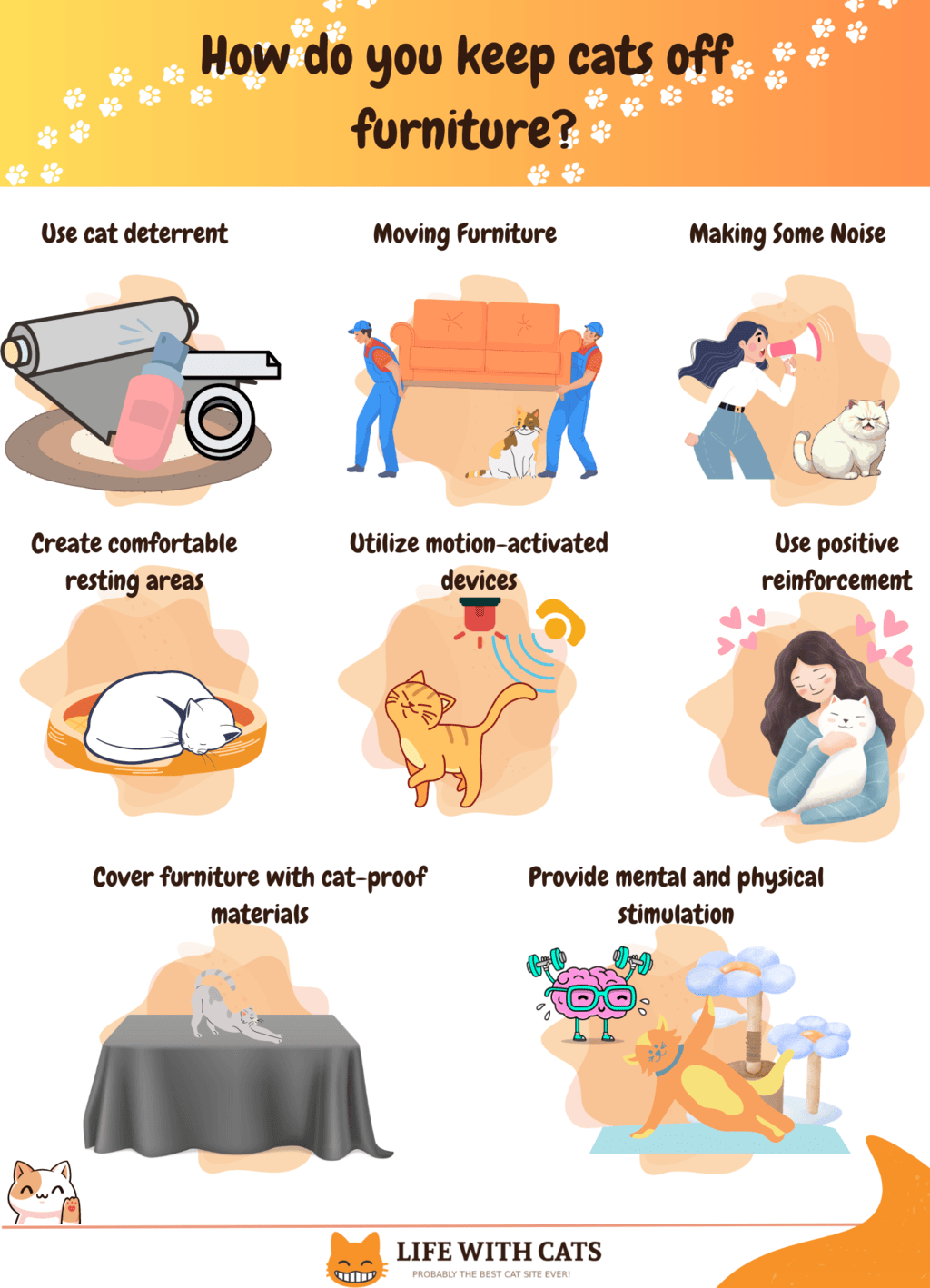
To keep cats off of your furniture, make sure you have a ton of tools in your arsenal to inhibit this behavior.
Use cat deterrent
Cat deterrents, as the name suggests, are things cats really don’t like to walk on. Here are a couple of common cat deterrents that can prevent your cat from climbing up on furniture.
- Aluminum Foil: Aluminum foil is a well-known cat deterrent. Cats hate the high-pitched sound of their paws crinkling on the foil. It’s also really shiny, which can disturb your cat’s keen sense of vision.
- Double-Sided Tape: If you apply double-sided tape to the edges of your counters or the back of the sofa, your cat will have a sticky residue on their paws every time they try to climb up. Your cat will really dislike this feeling, and the tape will deter them from climbing up again.
- Plastic Carpets: A plastic cat deterrent carpet has spikes on it. While these spikes won’t hurt your cat’s paws, it will make it quite uncomfortable to stand on the plastic carpet for a long time. So, you can line your shelves or the back of your sofa with this unique material.
- Homemade Spray: Using a strong-scented cat-repellent spray is a great way to protect your furniture. You can use ingredients like essential oils, vinegar, garlic, and citronella. While these smells won’t harm your cat, it will keep them away from wherever you’ve sprayed it.
Moving Furniture
Sometimes, the best way to keep your pets off of your furniture is to get it out of the way! You may not realize it, but your furniture might be set up in a way that allows your kitty easy access to way up high!
Try moving around your furniture, especially if you notice that your cat has a certain route he uses to get up. For example, if he jumps on the side table, the sofa, and then the shelves, try moving the side table so that he can’t jump up on the sofa.
Making Some Noise

Cats have very sensitive ears, so by making a loud noise each time your furry friend climbs up on your furniture, you will make him uncomfortable.
This will create a negative association between the action of climbing up on the furniture & the response of a loud, irritating noise. Just make sure it’s not too loud, as this could damage your cat’s hearing!
Create comfortable resting areas
Your cat may be climbing up because that vertical space is the only area where he can rest & relax. Try to create alternative resting areas for your kitty in safer spots. For example, you can purchase a cat tree. This satiates your furry friend’s urge to climb to secretive, furtive spaces; however, cat trees are totally safe & won’t hurt your cat or your wallet!
Utilize motion-activated devices
If nothing else seems to be working, you can also consider buying a motion-activated devices. These devices detect motion in a certain area, such as your kitchen counter or the back of your sofa.
When motion is detected, the device will emit a high-frequency squeal that is inaudible to humans, but very irritating to cats.
While this sound doesn’t hurt your kitty’s ears, it is definitely vexing enough to make them climb back down.
Use positive reinforcement
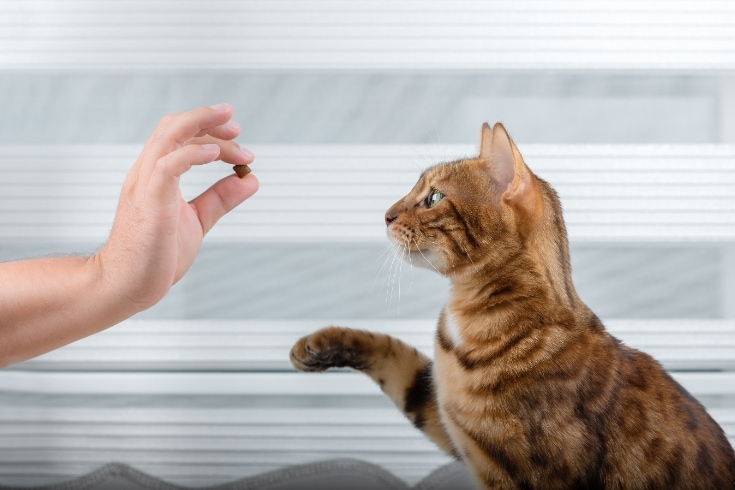
If you find that your cat is climbing up less, make sure you reward them with tons of praise, pets, and love! This will make performing the behavior a lot more appealing & form a positive association between staying in their cat-approved areas & getting rewarded.
Cover furniture with cat-proof materials
You may need to resort to covering your furniture with aluminum foil, spiky plastic carpets, double sided tape, & pet-deterrent spray. While this might not look the best, it will definitely work to keep your cat off your sofa!
Provide mental and physical stimulation
Make sure that your cat is living a super enriching and fulfilling life. The most common reason that pets act up is because they are bored & they need something to do to fill their time. Make sure that your cat is properly stimulated with toys & games.
Cats are natural predators, which means that they love toys & games where they have to chase after something. Playing with a toy mouse or a feather toy will leave your kitty feeling content, which means he is less likely to scratch up your furniture.
How to address relapse?
Relapse is basically when a fully-trained cat reverts back to how they were behaving before they were trained. This is more common than you would think. Since cats are very sensitive to changes, even something as small as moving around furniture can set back your training by 3-6 months!
Signs of relapse
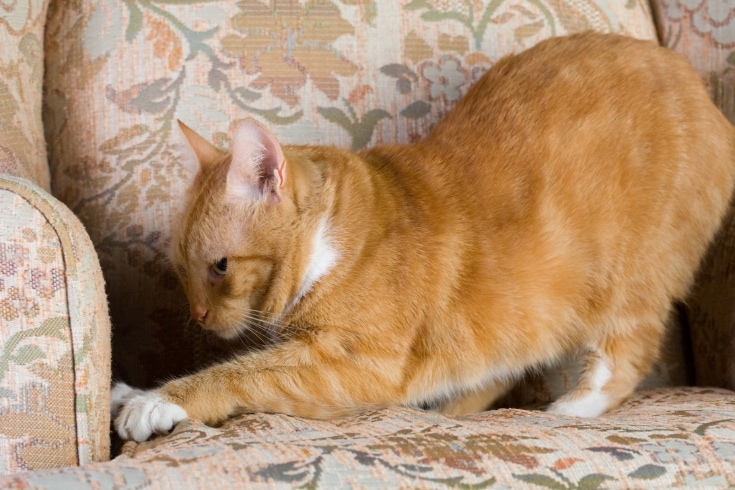
Some signs of relapse include jumping up on furniture, scratching, random bouts of aggression, & going to the bathroom outside of the litterbox. These are bad behaviors in cats that typically arise when your cat is stressed or feels insecure.
Addressing the root causes
As we discussed, relapse symptoms occur when your kitty feels stressed out or confused. While fixing the symptom may work short-term, it is much more beneficial to address the root cause of stress. Often, a relapse in training is due to a change in the environment. This could be due to moving around or changing out furniture.
Your home is your cat’s territory, and it is very easy for them to feel out of their element if you remove or move around certain things.
If moving around stuff is unavoidable, the best thing you can do is to keep your cat’s routine the same. Try not to move around any of their items, like their cat tower, food bowls, or litter box.
Reapplying training techniques
Unfortunately, when a cat has relapsed, you will need to start training them once again. This can be really frustrating for pet parents, but it’s crucial to remain calm & patient.
If you train them once again with consistency & calmness, you will find that your cat takes half as long to pick up the behaviors!
This is because he isn’t learning for the first time. Instead, he’s unlocking information that’s already there!
When to consider professional help?
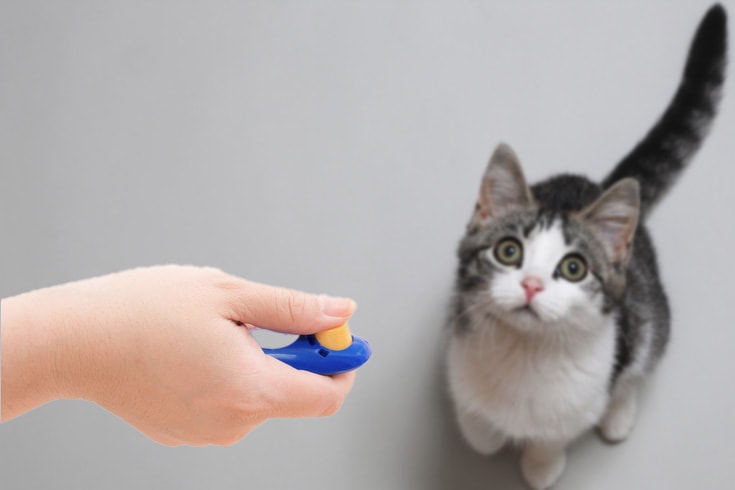
If you have been training your cat consistently for 3-6 months, but their behaviors are still too dangerous and difficult to deal with yourself, you may want to consider enlisting a professional.
Professionals, like cat trainers or animal behaviorists, work closely with your cat to identify & act on the root of his scratching issue.
Finding a reputable cat trainer
The cat trainer that you choose must be a reputable name. Look online on Facebook groups & Google Reviews to see what other kitty owners think of him. Not only should the cat trainer be efficient, but they should also be very gentle & respectful with your kitty.
They should also have good communication with their clients & a great understanding of cat behavior. Ensure that your trainer has solid qualifications & at least a few years of experience.
Expected outcomes of professional training
While training isn’t a golden ticket to a perfectly behaved cat, professional training is a great way for your cat to slowly learn what permissible & impermissible behaviors are.
Your cat should eventually respond better to commands and perform negative behaviors like scratching much less. After professional training, you may also find that it’s much easier to teach your cat new tricks & behaviors.
Keeping cats off Furniture FAQs
Here are some commonly asked questions about keeping your kitty (and his sharp claws!) off of your furniture.
What smells do cats dislike?
Cats hate strong scents like citrus, mothballs, eucalyptus, pine, vinegar, and cedar.
However, if you’re thinking about making a homemade cat repellent spray, be aware that certain essential oils can cause inflammation & damage to your cat’s sensitive nasal passages. These essential oils may even be toxic to your kitty.
Does vinegar keep cats away?
Yes! The strong acidic smell of vinegar is extremely unappealing to cats. Concentrated vinegar makes your cat’s nostrils feel like they are burning.
What home remedy will keep cats from scratching furniture?
If you want a fast, DIY solution to keep your cat from scratching the furniture, a go-to most pet parents use is to line their furniture with aluminum foil. Cats hate the reflected light and the noise that foil makes, which makes them less inclined to scratch on it.
You can also create a homemade kitty-repellent spray with ingredients like citrus extract, eucalyptus essential oil, vinegar, and mothballs!
Why do cats like hard surfaces?
Every pet parents has noticed that no matter how fancy their bed is, most cats will almost always choose the cold, hard floor. That often leaves us wondering why they wouldn’t choose their tempur-pedic mattress.
Cats prefer the cold, hard floor because it’s…well, cold & hard! Hard surfaces allow your cat to cool down quickly. They may also have the lingering scent of cleaning solution, which your cats may enjoy.
Are there specific types of furniture that are less appealing to cats?
Furniture with metal frames isn’t as fun as furniture with wooden frames, because it is less satisfying to scratch. Similarly, furniture with fabric is a lot more fun to claw at than furniture without delicate fabric.
Can you train an older cat to stop climbing or scratching furniture?
Yes you can! Training an older cat is definitely possible, although it might take a little bit longer than training a young cat. Older cats are usually a little less responsive to training, but with enough patience, treats, and positive affirmations, you can definitely train your older cat to stop jumping on your furniture!
Does aluminum foil keep cats away?
Yes! Aluminum foil makes an irritating noise when you touch it & reflects light. Both of these factors make it very annoying for cats, who have a keen sense of vision & sound. Cats will often avoid furniture lined with aluminum for this reason.
What repels cats from furniture?
There are tons of things that can make your furniture less appealing to cats. The easiest option is to make a homemade kitty repellent spray by diluting vinegar or citrus essential oil & applying liberally to your furniture.
You could also line your furniture with aluminum or use a plastic carpet so your cat can’t walk on it.
Conclusion
One of the most frustrating parts of owning a cat is dealing with the climbing & scratching. Cat parents know how irritating it is to come home to a ripped up pillow or a shredded sofa.
So, we found a couple of helpful tips to train your cat, how to keep your kitty off the furniture, and when to call in the big guns & hire a professional trainer.
If you found this article helpful, please share with your friends & family. Comment down below if you have any other useful tips for furniture training.
Thanks for reading!